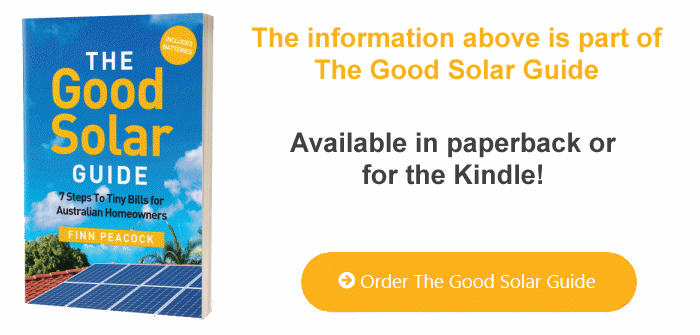STEP 2: Measuring Your Energy Use
← Know Your Rights | The Good Solar Guide Contents | Energy Audit Steps →
WARNING: This step involves opening your switchboard to look inside. Your switchboard contains deadly voltages. Do not touch anything in the switchboard. If you are not comfortable opening your switchboard, don’t do it.
Now you have a grounding in the basic knowledge needed to understand solar power and how it relates to your home and bill, you’re almost ready to jump into details of which solar panel brand to buy and how many of them to whack on your roof.
Before we do that, we need to step back and think about the problem we are trying to solve with those panels.
95% of people who buy solar tell me their main motivation is to lock in low bills for decades to come. But how can you be sure what your new bills after going solar will be?
The main factor that determines the payback of a solar power system on your home – and, therefore, determines what your new bills will be – is your ‘self-consumption ratio’.
Your self-consumption ratio is the percentage of generated solar electricity that you use in your house (the rest being exported to the grid).
If you can accurately predict how much of your solar energy will be self-consumed, you can accurately predict your new bills. If you can accurately predict your new bills, you can make an informed decision about whether to buy solar, how to finance it and what size to buy, based on your personal criteria for payback.
Accurately predicting your self-consumption takes some effort.
This step describes how to make that effort.
Tip
If you don’t want to do all the work outlined in this chapter – calculating your actual self-consumption ratio – the good news is that you don’t have to!
The lazy or impatient among you can assume that your self-consumption ratio will fall into a range:
- Assume your worst-case self-consumption is 10%.
- Assume your best-case self-consumption is 70%.
In Step 4, work out your worst- and best-case savings range using the two values above.
If you’re happy with worst-case savings, then you can get solar power safe in the knowledge that you’ll get savings in the range you’ve calculated.
For those of you who want to predict your solar savings more accurately, here’s how to perform a quick and dirty energy audit that will reveal your self-consumption ratio.
To get there we need to measure how much of your energy you use during the day – when the sun is shining – and how much you use at night. With these numbers, you can make a good estimation of solar’s financial return on your home before you get quotes (Step 4). You can also use your measurements to confirm the financial projections when you get firm quotes (Step 6).
← Know Your Rights | The Good Solar Guide Contents | Energy Audit Steps →
Questions or feedback about the content on this page? Contact me.
